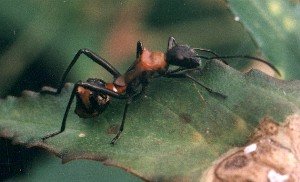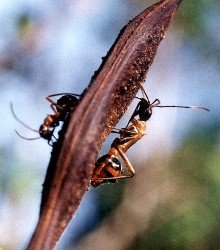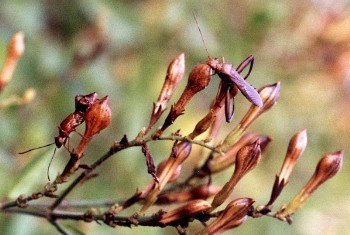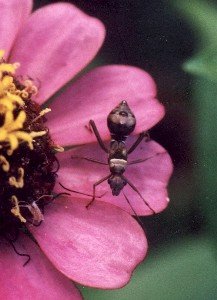Ant Mimics
by Valerie (September 2, 2000)
revised September 13, 2002

There are lots of species of ants around here, and lots of species of true bugs. From my observations in our gardens, we seem to have an unusually high number of bugs that mimic ants. I have often read about spiders that imitate ants, and was aware that bugs also do it, but have never found much information about the local species. 
The reason for mimicking ants is obvious: ants often have venomous stings (just look at our fireant problem) since they are related to bees and wasps, bitter tastes (due to formic acid), or strong jaws and large numbers, so a lot of predators avoid them. Tasty little morsels like bugs and spiders often do well to look like something less appetizing.
The bugs pictured here appear to be different species or there is just a lot of variety within one or two kinds. They were all photographed in Austin, and I have seen them in different locations, so they are very common. In our gardens, sometimes they are quite numerous and other times there are almost none. Size ranges from about ¼ to over ½ inch in length.
The resemblance to ants is very striking, but the bugs are more ornate than any ants in this area, as well as growing as large as carpenter ants. The real giveaway is the piercing/sucking mouth appendage that allows the insect to extract liquid from plants. This is visible in two of the photos; it is folded back under the bug's head. I'm pretty sure that none of the ant mimics are predatory, but not positive. I've often found them feeding on the seed pods of legumes and acacia-type plants. Another favored plant seems to be the wild poinsettias. They are always adorned with brown, rust, grey or black stripes, and/or possess spines and protuberances. Although they may be numerous, these bugs seem to be relatively solitary and I only occasionally find more than one at a time. They certainly do not cluster in groups like many other bug species.
These insects are the nymphs of a group called the broad-headed bugs. The adults are quite different in appearance, still maintaining the slender physique, but gaining wings and losing the ant look, as can be seen in the last photo, but some of the intermediate stages show characteristics of both.
 |
